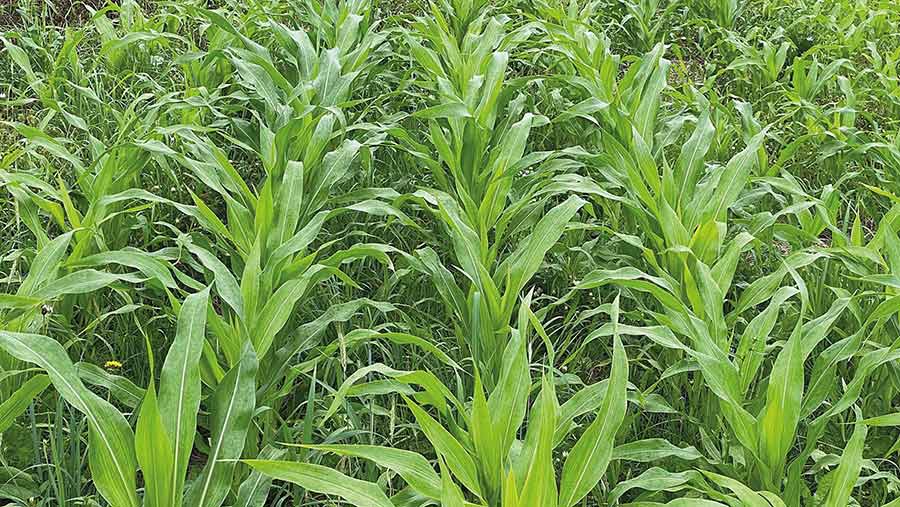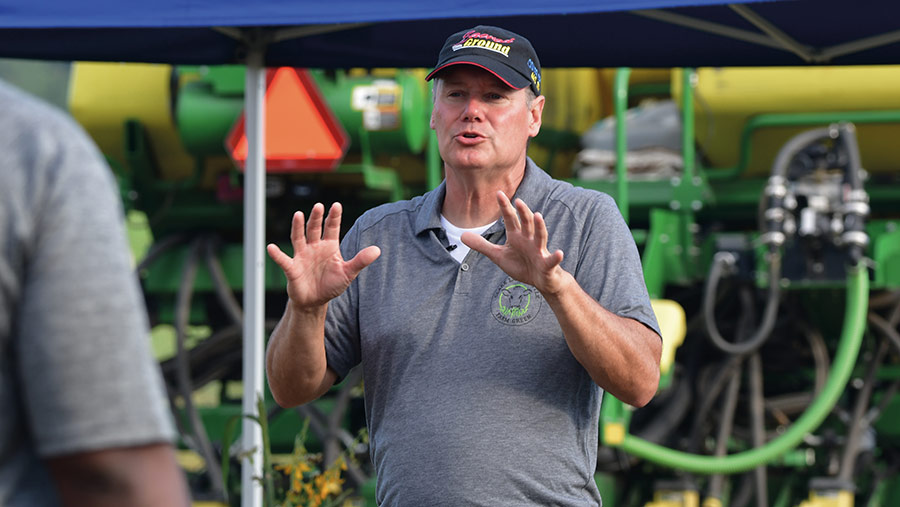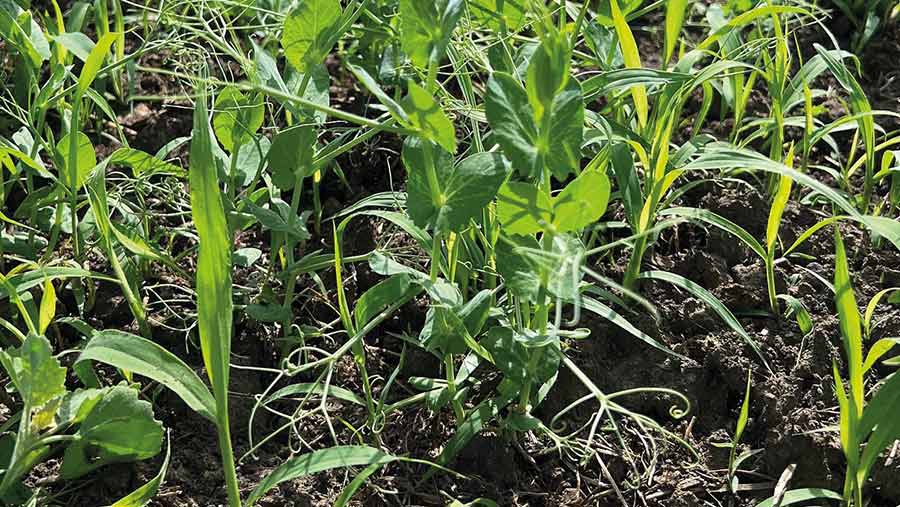Organic no-till system saves US grower £1.6m in costs annually
 Maize planted into hairy vetch on Rick Clark's farm © Rick Clark
Maize planted into hairy vetch on Rick Clark's farm © Rick Clark US farmer Rick Clark calculates that he is taking £1.62m of costs out of his 3,000ha Indiana farm business on an annual basis, thanks to the organic no-till regime he has developed on the family farm.
In what he describes as “farming green”, Mr Clark plants cash crops into living cover crops, making maximum use of plant diversity to build soil health, encourage photosynthesis and take advantage of synergies.
In doing so, he has eliminated the use of all synthetic inputs, as well as drastically reducing his need for diesel and horsepower.
See also: Polish growers see high OSR yields after move to biologicals

Rick Clark © (supplied by) Rick Clark
His whole farm system is based on just three passes in one year, with soil health improvement underpinning all his decisions.
For this reason, weekly measurements are done, so that he can monitor progress and understand what changes are occurring.
“Whatever test you use, it’s a snapshot in time. But without this sort of data, we don’t have a baseline or know what’s happening as we change things.”
‘Farming green’ definition
Planting the cash crop into a living, growing, green cover crop. Termination may not occur for up to 30 days after planting, but typically happens before that.
Yield v profitability
He makes a distinction between being regenerative rather than sustainable, believing that farmers must take everything away in terms of inputs to truly be regenerative – stressing that it may be necessary to do the unmentionable and sacrifice yield to maintain soil health.
“This system isn’t all about yield – it’s about profitability – although we find that yields come along for the ride,” he explains.
Farmers who want to reduce costs, but would struggle to go cold turkey with inputs are encouraged to meet him in the middle and should strive to eliminate half of them, he suggests.
“On this farm, we haven’t used any fungicides and herbicides in eight years, or any insecticides,” he says.
“Nor have there been any applications of nitrogen in the last three years, while the use of phosphate, potash and lime was eliminated long before that.”
Cover crop biomass
Organic and no-till is a difficult combination, admits Mr Clark, who says he has had to tread lightly and be prepared to be nimble and make changes without much warning.
“Weed suppression has been the biggest challenge and we need to get biomass into our cover crops to help with that.”
Early establishment of cover crops achieves that biomass requirement. He works on a 70:30 principle, where cover crops provide 70% of the weed suppression and the cash crop does the remaining 30%.
A good example is where soya beans are drilled into a standing cover crop of cereal rye. He comes back and rolls the cover 40 days later, so that weeds are kept at bay and nutrients continue to be captured.
“Our covers are feeding the next crop and suppressing weeds at the same time. You need to be patient to get this ‘give and take’ working well.”
Annual savings from farming green on Rick Clark’s farm |
|
| Diesel | £50,963 |
| Nitrogen | £489,414 |
| Phosphate | £270,189 |
| Potash | £280,705 |
| Lime | £101,927 |
| Agrochemicals | £390,722 |
| Seed | £84,939 |
Working with nature
Mr Clark adds that he has made the wider system work by balancing it with Mother Nature in a symbiotic relationship.
Multi-species cover crop mixes, an eight-crop rotation and integrated grazing have provided diversity and improved soil health – with flexibility also being important.
Having recognised the importance of mycorrhizal fungi in soil function, he now does everything to promote this “backbone of the microbial community”, so that the fungi can thrive and help make nutrients available for the plants to use.
“Given time, a continuing cycle develops in which nutrients are sequestered and used, due to the soil microbes being able to do their job.”
Mr Clark follows six main principles of soil health – from minimising both soil and chemical disturbance and maximising diversity to keeping living roots going and having the soil covered, as well as integrating livestock and always considering the context.
“Tillage destroys the valuable fungal networks that we need for nutrient cycling, while chemical disturbance upsets the predator to prey balance,” he says.
“Tillage and chemistry is a bad combination – in contrast, when a farm is close to balance, pests don’t have a negative effect on yield.”
Soil cover
Keeping the soil covered or armoured helps with temperature regulation and prevents moisture loss in the heat, as well as reducing erosion, he adds.
“It also means that you are not putting a seed into a hostile environment at drilling.”
Compared to how the farm used to be run, some £390,722 is being saved on chemistry, £525,817 on nitrogen, £270,189 on phosphate and £280,705 on potash.
His diesel use has come down by 50%, saving £50,963 and the horsepower requirement has fallen by 64%.
“These are annual savings,” he stresses.
Having started with no-till soyabeans 18 years ago, Mr Clark introduced cover crops in 2010. He now includes livestock as one of his eight crops and also has some ‘regenerative acres’, or land with no cash crop on it.
“Every now and then, I take a bit of land out of production and give it a cover crop cocktail, just to get it back into balance for the next cash crop. A regen year is accounted for as an average of our seven-to-eight year system.”
While that might be a difficult concept for those paying rent, he points out that stewardship of the land is essential for getting the best from it.

Peas and maize on Rick Clark’s farm © Rick Clark
Nutrient capture
With maize, wheat, soyabeans, alfalfa, milo and peas grown, as well as cattle grazed, there are plenty of opportunities to include multi-species cover crops.
As well as holding lots of nutrients, they help to create an environment in which weed species won’t germinate.
“We often crimper roll them, which creates a mat and helps to keep weeds down.”
The cover crops are just as important as the cash crops, believes Mr Clark.
He includes legumes to capture nitrogen for use by the following crop and is adamant that he can fix more than enough of the nutrients for the farms’ needs.
“I’m often asked how much of the nitrogen captured will be made available,” he says.
“The answer is not all of it – but at least half will be. We manage that nitrogen differently in the early part of the season by letting the covers go further into their growth cycle, which is why we’ve been able to cut out synthetic nitrogen.”
Photosynthesis drives the system, as green plants capture sunlight and carbon dioxide to produce sugars and carbon compounds.
Some of these are exuded from their roots into the soil profile, where they feed the soil microbes in an active mutually beneficial process and create aggregate stability.
“Take advantage of the free stuff,” urges Mr Clark. “Sunlight and nitrogen are all around us.”
His final point is that changing a farming system is hard and requires commitment. “If you are not uncomfortable with what you are doing, you are not trying hard enough to change.”
• Rick Clark was speaking at the East of England Farming Conference
Benefits of Farming Green
The system maximises what the cover crop is intended for:
- Sequesters nutrients
- Fixes nitrogen
- Grows carbon
- Limits soil erosion
- Increases biomass
- Feeds soil microbes
- Armours the soil
- Builds human health
- Encourages good stewardship
- Improves return on investment

